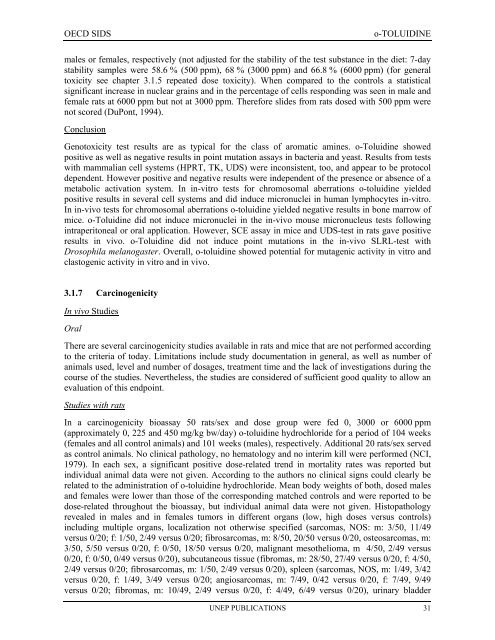o-TOLUIDINE CAS N°: 95-53-4 - UNEP Chemicals
o-TOLUIDINE CAS N°: 95-53-4 - UNEP Chemicals
o-TOLUIDINE CAS N°: 95-53-4 - UNEP Chemicals
Create successful ePaper yourself
Turn your PDF publications into a flip-book with our unique Google optimized e-Paper software.
OECD SIDS o-<strong>TOLUIDINE</strong><br />
males or females, respectively (not adjusted for the stability of the test substance in the diet: 7-day<br />
stability samples were 58.6 % (500 ppm), 68 % (3000 ppm) and 66.8 % (6000 ppm) (for general<br />
toxicity see chapter 3.1.5 repeated dose toxicity). When compared to the controls a statistical<br />
significant increase in nuclear grains and in the percentage of cells responding was seen in male and<br />
female rats at 6000 ppm but not at 3000 ppm. Therefore slides from rats dosed with 500 ppm were<br />
not scored (DuPont, 1994).<br />
Conclusion<br />
Genotoxicity test results are as typical for the class of aromatic amines. o-Toluidine showed<br />
positive as well as negative results in point mutation assays in bacteria and yeast. Results from tests<br />
with mammalian cell systems (HPRT, TK, UDS) were inconsistent, too, and appear to be protocol<br />
dependent. However positive and negative results were independent of the presence or absence of a<br />
metabolic activation system. In in-vitro tests for chromosomal aberrations o-toluidine yielded<br />
positive results in several cell systems and did induce micronuclei in human lymphocytes in-vitro.<br />
In in-vivo tests for chromosomal aberrations o-toluidine yielded negative results in bone marrow of<br />
mice. o-Toluidine did not induce micronuclei in the in-vivo mouse micronucleus tests following<br />
intraperitoneal or oral application. However, SCE assay in mice and UDS-test in rats gave positive<br />
results in vivo. o-Toluidine did not induce point mutations in the in-vivo SLRL-test with<br />
Drosophila melanogaster. Overall, o-toluidine showed potential for mutagenic activity in vitro and<br />
clastogenic activity in vitro and in vivo.<br />
3.1.7 Carcinogenicity<br />
In vivo Studies<br />
Oral<br />
There are several carcinogenicity studies available in rats and mice that are not performed according<br />
to the criteria of today. Limitations include study documentation in general, as well as number of<br />
animals used, level and number of dosages, treatment time and the lack of investigations during the<br />
course of the studies. Nevertheless, the studies are considered of sufficient good quality to allow an<br />
evaluation of this endpoint.<br />
Studies with rats<br />
In a carcinogenicity bioassay 50 rats/sex and dose group were fed 0, 3000 or 6000 ppm<br />
(approximately 0, 225 and 450 mg/kg bw/day) o-toluidine hydrochloride for a period of 104 weeks<br />
(females and all control animals) and 101 weeks (males), respectively. Additional 20 rats/sex served<br />
as control animals. No clinical pathology, no hematology and no interim kill were performed (NCI,<br />
1979). In each sex, a significant positive dose-related trend in mortality rates was reported but<br />
individual animal data were not given. According to the authors no clinical signs could clearly be<br />
related to the administration of o-toluidine hydrochloride. Mean body weights of both, dosed males<br />
and females were lower than those of the corresponding matched controls and were reported to be<br />
dose-related throughout the bioassay, but individual animal data were not given. Histopathology<br />
revealed in males and in females tumors in different organs (low, high doses versus controls)<br />
including multiple organs, localization not otherwise specified (sarcomas, NOS: m: 3/50, 11/49<br />
versus 0/20; f: 1/50, 2/49 versus 0/20; fibrosarcomas, m: 8/50, 20/50 versus 0/20, osteosarcomas, m:<br />
3/50, 5/50 versus 0/20, f: 0/50, 18/50 versus 0/20, malignant mesothelioma, m 4/50, 2/49 versus<br />
0/20, f: 0/50, 0/49 versus 0/20), subcutaneous tissue (fibromas, m: 28/50, 27/49 versus 0/20, f: 4/50,<br />
2/49 versus 0/20; fibrosarcomas, m: 1/50, 2/49 versus 0/20), spleen (sarcomas, NOS, m: 1/49, 3/42<br />
versus 0/20, f: 1/49, 3/49 versus 0/20; angiosarcomas, m: 7/49, 0/42 versus 0/20, f: 7/49, 9/49<br />
versus 0/20; fibromas, m: 10/49, 2/49 versus 0/20, f: 4/49, 6/49 versus 0/20), urinary bladder<br />
<strong>UNEP</strong> PUBLICATIONS 31
















